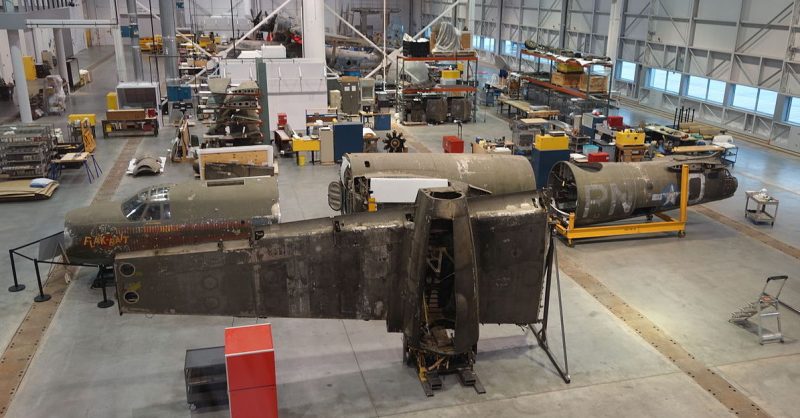The Smithsonian’s National Air and Space Museum staff has a big challenge. They are trying to preserve Flak-Bait, a Martin B-26 Marauder bomber famous for its exploits in World War II. Where most restorations seek to return something to “like new” condition, doing so with this plane would remove the historical damage it sustained in battle.
Team leader Pat Robinson, museum specialist Chris Moore, conservators Laruen Horelick and Malcolm Collum are working in the Mary Baker Engen Restoration Hangar at the Steven F. Udvar-Hazy Center in Chantilly, Virginia. They are analyzing the composition of the plane’s paint, stabilizing the layers of paint and carefully removing layers of dirt, not to make it bright and shiny, but to restore the plane’s character earned through its involvement in some of WWII’s biggest battles.
As if that didn’t make it tough enough, they need to be able to reverse the step they take in case future conservators find improved ways to accomplish the same tasks.
Jeremy Kinney, curator of American military aviation at the Air and Space Museum, explains the issue. “There are planes that did see combat but were completely restored, so the essence of what they experienced during World War II is gone. Flak-Bait is a true time capsule of that time. We want to maintain its essence and authenticity.”
Flak-Bait was dismantled in Europe and sent to the Smithsonian in 1960. The plane flew 207 missions during the war, a record for American planes. To put it in perspective, the typical American bomber flew 15 to 20 missions in its lifespan.
Flak-Bait sat in storage after returning to the States. In 1976, the museum put the forward section of the plane on display. The rest of the plane remained in storage. It was packed so well that the team found bright red hydraulic fluid still in the brake lines.
Now, tasked with putting the entire plane back together, the team is using science to precisely clean away the dust and dirt accumulated from storage while leaving the historically significant dirt and mud of European airfields intact. One of the team’s projects was removing historical artifacts like Wrigley’s gum wrappers, cigarette butts, chaff shavings and bomb tags from between the two bomb bay doors.
One of the biggest challenges lies in preserving the paint job. In order to save hundreds of pounds from the weight of the plane, primer was not used when painting the fuselage. That has led to the paint flaking off of the aluminum body.
In the past, conservators would simply cover the body with a fresh coat of paint, pull the dents and fill in the cracks. That is not the approach the team is taking with Flak-Bait.
“If we were to completely reverse some things, we would be taking things off that people put on in 1945,” says Kinney. “We want to clean it up as it was found then.”
The team is preserving the dozens of bullet and shrapnel holes as a record of the bombing missions it was on. They are also preserving the thousands of pencil signatures on the body placed there by people who recognized the celebrity status of the plane and sought to preserve their moment with it.
This fall, the team will methodically analyze the different paints on the plane. They’ll look at the chemical composition and examine it microscopically. They’ll also determine what they can use to keep the existing paint from flaking off of the metal without altering the plane’s appearance.
It’s expected that this process will most of next year. The team will create mockup panels using materials as similar to the plane’s as possible and then test different methods on those panels. The panels will then go into artificial aging chambers to test how the methods hold up over the next 100 years as a museum display piece.
After the restoration is finished, the project doesn’t end. Decisions made this year will affect how the plane is cared for in the future, so they need to carefully consider the materials and processes they use today, Smithsonian Insider reported.
“We need to think about how it will be cared for in the future. We can’t just not do anything. We need to make sure we can preserve it,” said Horelick.
Due to the painstaking nature of the work, the team is not expecting the plane to be ready for display until 2021.
 Photo Credit"
title="Martin B-26B-25-MA Marauder "Flak-Bait" restoration, National Air and Space Museum.
Photo Credit"
title="Martin B-26B-25-MA Marauder "Flak-Bait" restoration, National Air and Space Museum.